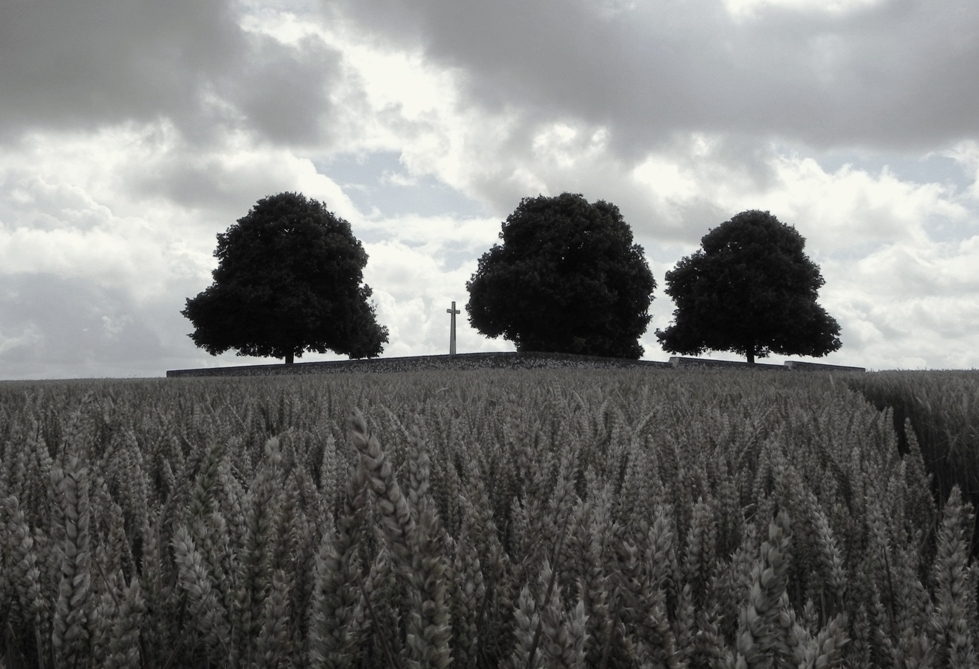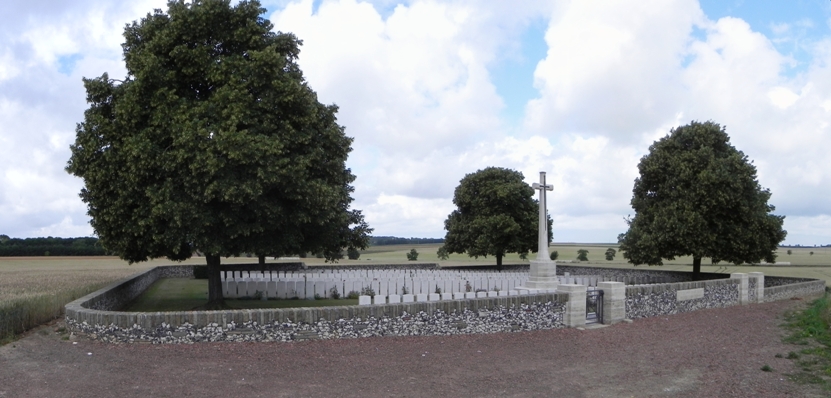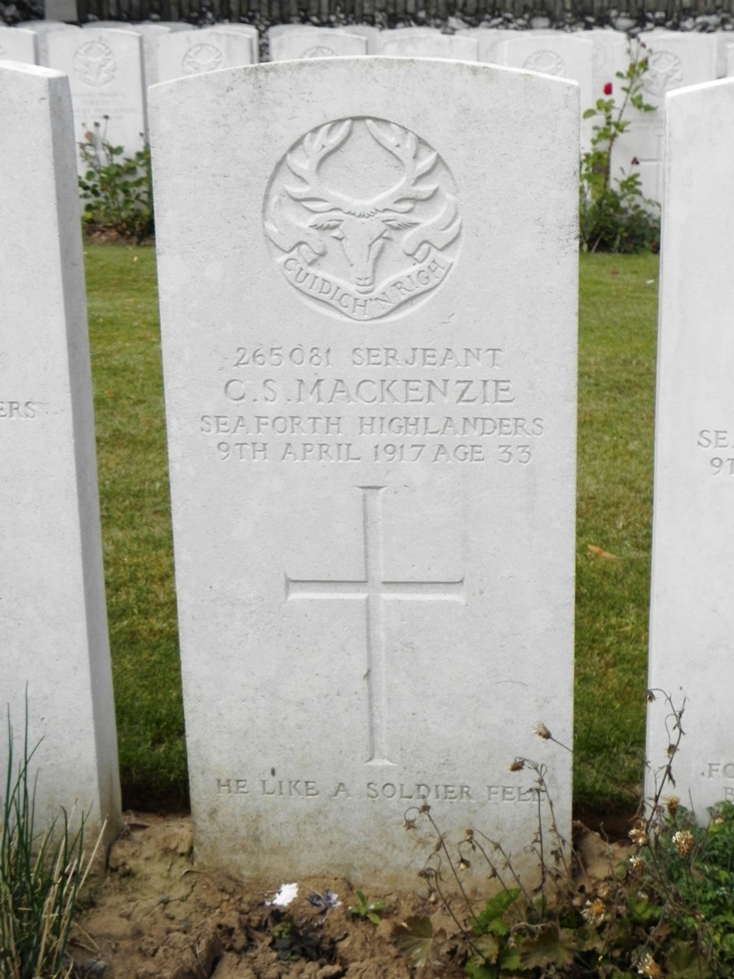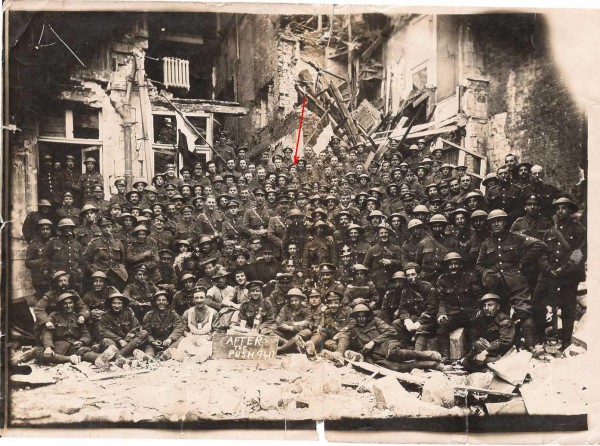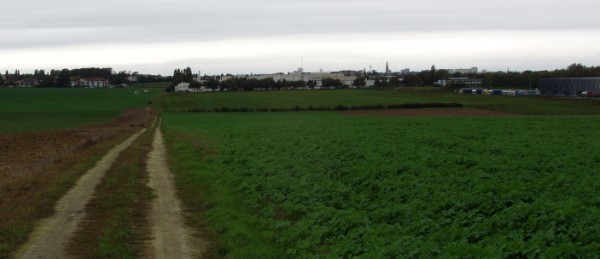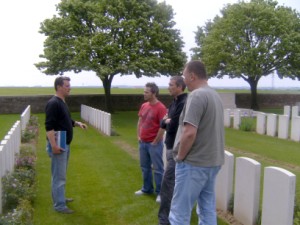Posts Tagged ‘Arras’
6th Seaforth Highlanders at Roclincourt – The Battle of Arras, 9 April 1917
Last month I managed to stop in at the Arras battlefields when on my way down to La Boisselle for more site work. I only had a couple of hours before a lunchtime meeting in Peronne but still managed a quick recce for a private battlefield tour I am taking in September.
I have some clients coming from New Zealand who have a relative, Corporal Andrew McDonald MM, who was fatally wounded at the Battle of Arras. I have been compiling a detailed report on this soldier who served in the 6th (Morayshire) Battalion of the Seaforth Highlanders.
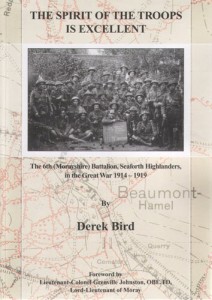
Derek Bird - "The Spirit of the Troops is Excellent." A first-class study of the battalion - highly recommended reading.
Andrew McDonald was in the battalion from its very formation and arrived in France in 1915. As part of 152 Brigade, 51st (Highland) Division he served throughout the Somme offensive including Bazintin-le-Grand, High Wood and the successful capture of Beaumont Hamel in November. He was awarded the Military Medal for his part in a raid on enemy positions in September 1916 on the Railway Salient near Armentieres. A most useful book on the battalion is Derek Bird’s ‘The Spirit of the Troops is Excellent’ which I can heartily recommend as a superb battalion study.
On the opening day of battle, Easter Monday, 9 April 1917 the battalion was to be involved from the off. Facing the German trenches northeast of the small village of Roclincourt they were tasked with capturing three lines of German trenches, the third of which was designed the Black Line. They would then consolidate these whilst the 1/5th Seaforths passed through them in the ‘leap-frog’ system to take the next two lines, the Brown and Blue Lines.
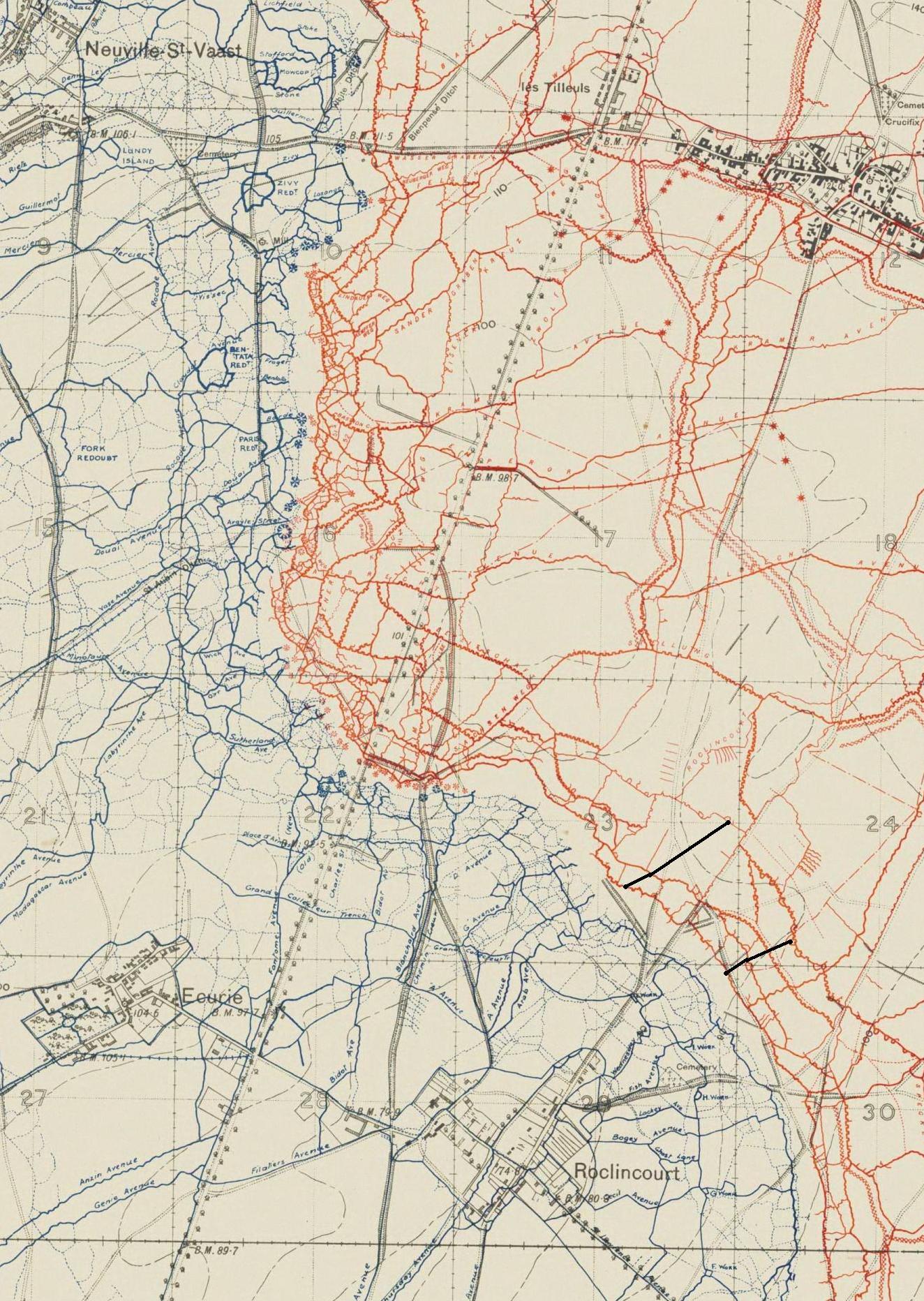
Trench map of Roclincourt-Neuville-Thelus sectors. The black lines are the boundaries for the 6th Seaforths attack on 9 April 1917. CLICK map to enlarge.
Andrew McDonald was serving in C Company – they had even more limited objectives, being tasked with taking and holding a section of the first two lines. D Company with a platoon of B Company would then push on to the Black Line – the final objective for the battalion.
As Andrew McDonald’s service record no longer survives it is very hard to know where he was fatally wounded and the war diary offers scant evidence. However, in September I will take his relatives, having travelled half way around the world, to the site of the jumping-off trenches occupied by C Company and let them stand where he stood on 9 April 1917. I am pretty confident that he was wounded in the fields in front of us, rising towards Farbus and Thélus on the southern shoulder of Vimy Ridge. The beautiful Highland Cemetery now stands close to the site of C Company’s advance. It is full of Highland Division men and is well worth a visit.
One casualty buried in the cemetery that particularly stood out for me whilst reading Derek Bird’s book was Sergeant Charles Mackenzie who was reportedly killed while engaged in a bayonet fight. One of his men was bayoneted and in a selfless act Mackenzie stood over his body to protect him from further wounding. Sadly he himself was then overcome and killed.
Fatally wounded on 9 April Andrew McDonald succumbed to his wounds on 13 April, having made it back to the huge hospitals near Etaples. He is buried in the vast and sobering Etaples Military Cemetery, another spot my clients will visit on their September pilgrimage.

Panorama overlooking Highland Cemetery. It is taken close to the site of the Battalion HQ during the opening stages of the Battle of Arras. The tree lined road on the left takes you to Thelus.
All of this took place just off the A26 motorway so please spare a thought and look to your right and the lonely Highland Cemetery just past Junction 7 next time you are heading south.
Total losses for the Battalion during the opening stages of the Battle of Arras were 9 Officers and 320 Other Ranks. Further trials awaited the battalion later in the month at Roeux and the Chemical Works during some of the most savage infantry fighting of the war. For those with an interest in the battalion Derek Bird has compiled a Roll of Honour to the fallen of the 6th Seaforths. It can be viewed here: http://www.scotlandnorthbranch.webspace.virginmedia.com/Roll-of-Honour/Index.htm
I spoke at the Thames Valley Branch of the Western Front Association (WFA) last Thursday (28 April). When first approached I had to choose between speaking about the Livens Large Gallery Flame Projector on the Somme or the subject of our last book, The Battle of Arras. I opted for the latter, mainly because I figured that the Channel 4 Time Team programme would have been only shown a short time before and so many of those attending would know at least the gist of the story. So, Arras it was. The talk was to last for about an hour (as it was, I think I spoke for nearer 70 minutes) and so this necessitated a good deal of reading to refresh the memory. I prepared a PowerPoint presentation to illustrate some aspects of the talk and managed to get panoramas to slowly scroll across the screen too (a technical feat I was quite pleased with!)
The talk was entitled “The Battle of Arras: April – May 1917? and was well attended with about 45 people regulars plus my brother Mark Banning and his friend and regular battlefield companion Malcolm Sime.
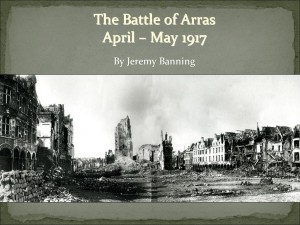 It was structured to not merely cover the battle but start with warfare in the Arras area in October 1914, look at the costly French actions of 1915 and then move on to British occupation in March 1916. The German attack against the 47th (London) Division on Vimy Ridge was touched upon and then I covered a basic backdrop to battle from the political and military standpoint and explained in detail the new German policy of ‘elastic defence’ to be brought into play for 1917. Moving through the Chantilly and Calais conferences I then spent some time on the German retreat to the Hindenburg Line (Operation Alberich) before exploring preparations for battle such as the tremendous work of the Royal Engineers. I also looked into French preparations, the actions of General Robert Nivelle and the extraordinary series of leaks and security lapses that marred the French pre-battle period. By this time half an hour had gone but I felt it important to set the scene fully and not merely delve straight into the battle itself.
It was structured to not merely cover the battle but start with warfare in the Arras area in October 1914, look at the costly French actions of 1915 and then move on to British occupation in March 1916. The German attack against the 47th (London) Division on Vimy Ridge was touched upon and then I covered a basic backdrop to battle from the political and military standpoint and explained in detail the new German policy of ‘elastic defence’ to be brought into play for 1917. Moving through the Chantilly and Calais conferences I then spent some time on the German retreat to the Hindenburg Line (Operation Alberich) before exploring preparations for battle such as the tremendous work of the Royal Engineers. I also looked into French preparations, the actions of General Robert Nivelle and the extraordinary series of leaks and security lapses that marred the French pre-battle period. By this time half an hour had gone but I felt it important to set the scene fully and not merely delve straight into the battle itself.
I structured the actual battle part of the talk by focussing on the First and Third Army fronts from north to south, starting with the Canadian Corps attack on Vimy Ridge before moving into what I always think of the main ‘Arras proper’ battlefield. Realising that no talk about the Battle of the Somme would neglect to work its way down the front line for 1 July 1916 I adopted the same structure – following each division’s success (or failure) as we moved southwards across the Scarpe and Arras-Cambrai road into Hindenburg Line territory until ending with the 21st Division at the south of the attacking frontage. Explaining the reasons for success in many sectors and failure in others I then worked my way through the battle focussing on stand-out actions. These included the capture of Monchy-le-Preux on 11 April 1917 and the destruction of the cavalry of the Essex Yeomanry and 10th Hussars in the village.
I also covered the attack by two battalions of the 10th Brigade (4th Division) towards the village of Roeux and the Chemical Works. 1/Royal Irish Fusiliers and 2/Seaforth Highlanders suffered grievous losses in the attack; the Seaforths attacked with 12 officers & 420 Other Ranks and their losses were all 12 officers & 363 O.R. This meant that a mere 57 men survived the action unwounded – and the objective wasn’t gained in any way. The beautiful Seaforths Cross on the Sunken Lane at Fampoux is a reminder of the men who attacked and suffered so much that day. I touched on the fighting at Bullecourt that day but felt that the disastrous actions around that particular salient village warranted a talk of their own.
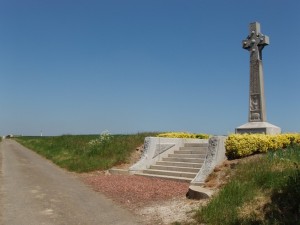 The next attack to be looked into was the attack up Infantry Hill by the Newfoundland Regiment and 1/Essex Regiment on 14 April 1917 – an attack that almost destroyed both battalions and which left the way open for the German reoccupation of Monchy. The day was saved by a gallant band of men led by Lt Col James Forbes Robertson, CO of the Newfoundlanders who organised a small group of men to run to eastern buy discount ambien edge of village and open rifle fire. For five hours their fire held the Germans at bay until the village was relieved. All were decorated and became known as ‘The Men Who Saved Monchy’.
The next attack to be looked into was the attack up Infantry Hill by the Newfoundland Regiment and 1/Essex Regiment on 14 April 1917 – an attack that almost destroyed both battalions and which left the way open for the German reoccupation of Monchy. The day was saved by a gallant band of men led by Lt Col James Forbes Robertson, CO of the Newfoundlanders who organised a small group of men to run to eastern buy discount ambien edge of village and open rifle fire. For five hours their fire held the Germans at bay until the village was relieved. All were decorated and became known as ‘The Men Who Saved Monchy’.
I then worked through the month of April, looking at the failed French attacks on the Aisne and then explaining the movements of 23 April (Second Battle of the Scarpe) with particular emphasis on the fighting for Roeux and the Chemical Works by the 51st (Highland) Division. The battle was deteriorating against well organised and deployed German troops employing the new ‘elastic defence’ doctrine. It was a dreadful time – Third Army suffered 8,000 casualties alone on the 23rd/24th April.
It seemed apt giving the talk on 28 April as I then touched on the attack that day 94 years ago and the capture of the village of Arleux. It was building to the climax of battle – the Third Battle of the Scarpe on 3 May 1917 – a very dark day indeed for the British Army. The 21km frontage from Fresnoy in the north to Bullecourt (again) in the south lent itself to particular problems. The Australians at Bullecourt wanted a night attack to aid their chances of success – in the north this would have been disastrous for the attack on Oppy Wood. A miserable compromise was reached and Zero Hour was set for 3.45am – the attack was still to go in at night time. It was a terrible fiasco – many units were unable to even find their starting points and had no idea of direction to attack, merely following the direction of the artillery barrage with the hope of finding some Germans. Accounts mention morale being poor and a general malaise amongst the depleted attacking divisions. I read from the Official History: Military Operations France and Belgium 1917 by Cyril Falls as it summed up most eloquently the reasons for failure on 3 May 1917:
“The confusion caused by the darkness; the speed with which the German artillery opened fire; the manner in which it concentrated upon the British infantry, almost neglecting the artillery; the intensity of its fire, the heaviest that many an experienced soldier had ever witnessed, seemingly unchecked by British counter-battery fire and lasting almost without slackening for fifteen hours; the readiness with which the German infantry yielded to the first assault and the energy of its counter-attack; and, it must be added, the bewilderment of the British infantry on finding itself in the open and its inability to withstand any resolute counter-attack.”
I concluded with the finals stages of battle, the loss of Fresnoy and eventual capture of Roeux and the Chemical Works and for my last slide whilst talking about the men who had done the fighting I showed one of my favourite pictures. It shows a triumphant shot of a group of the 12/West Yorkshire Regiment in Arras celebrating their success of 9 April with captured booty. I was amazed when a man in the front put his hand up, saying he had spotted his grandfather in the photo! Apparently the only wartime souvenirs that his grandfather left were his medals and a copy of this photo. The man was 50496 Acting Corporal John Davison Johnson (marked with a red arrow in the photo) and I thank his grandson, John Johnson for this information – it quite made my night!
All feedback received has been good and the Branch Chairman, Bridgeen Fox, wrote very warmly afterwards with her thanks. Her comments can be read here. As she herself said, “it should have raised the profile of the battles of Arras and I hope it will have encouraged more people to explore the area”.
When I have some time I will write a blog piece with detail about the 3 May fighting. My thanks to Geoff Sullivan from the wonderful ‘Geoff’s Search Engine’ for furnishing me with some tremendous statistics for that day. If anyone is intersted in hearing this talk then please contact me. I am speaking on this subject in Bristol in October – see here for details. For those with an interest in the battle our panorama book on the subject is available here. Alternatively, if you are interested in a battlefield tour to Arras then please contact me – I would be happy to discuss.
I had been invited to attend the annual service of commemoration for the Battle of Arras at the Wellington Quarry and had written a blog piece about the impending service which had been picked up by the WFA for inclusion on their website. Sadly I was unable to attend due to family commitments but I have been sent images and details of the event by Isabelle Pilarowski of the Wellington Quarry. The service is held at 0630hrs on 9 April each year. The early start is due to the start of battle in 1917 – Zero Hour was 5.30am. It is a gathering of people who want to pay their respects for the men involved in the huge British offensive at Arras in April and May 1917. So often overshadowed by the Battles of the Somme and Passchendaele, Arras stands as one of the three major British offensives of the war.
 I have a huge soft spot for the place, as a battlefield and a superb town to visit, and enjoy the quiet surroundings without the hordes of coaches and resulting pilgrims that can often be seen in some of the more popular battlefield stops on the western front.
I have a huge soft spot for the place, as a battlefield and a superb town to visit, and enjoy the quiet surroundings without the hordes of coaches and resulting pilgrims that can often be seen in some of the more popular battlefield stops on the western front.
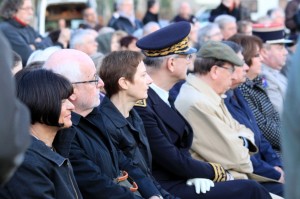 Isabelle tells me that the service went very well and that it was well attended by officials and visitors alike. Attendees included the Mayor, the Préfet, the Ambassador of New Zealand, representatives from Australia and Canada [denoting their countries role in the Battle – at Bullecourt and Vimy] as well as members from other French and British associations.
Isabelle tells me that the service went very well and that it was well attended by officials and visitors alike. Attendees included the Mayor, the Préfet, the Ambassador of New Zealand, representatives from Australia and Canada [denoting their countries role in the Battle – at Bullecourt and Vimy] as well as members from other French and British associations.
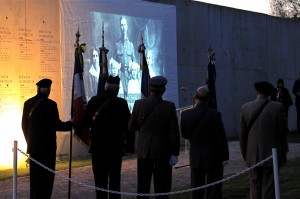 Of particular interest to me was the inclusion of extracts from the wonderful memoirs of Percy Clare, 7th East Surrey Regiment. As part of the 12th (Eastern) Division his battalion attacked up Observation Ridge on the first day of battle. After a rest in the middle of April the battalion was back in the line for the disastrous attacks of 3 May 1917 (Third Battle of the Scarpe) – 94 years ago today. The day is one of the blackest days for the British Army in the Great War and was a hideous muddle from its inception to its execution. Over 5,900 men were killed that day as the attack was repulsed with ease along the vast majority of the Thurd Army front. Very kindly the copyright holder, Rachel Gray, had let me copy a set of Percy’s memoirs for donation to the Wellington Quarry. They are probably the finest account extant of the battle and were quoted through the service. The service also included a reading of the poem ‘The Owl’ by Edward Thomas. He was killed on the morning of 9 April 1917 by a shell blast and is buried in Agny Military Cemetery:
Of particular interest to me was the inclusion of extracts from the wonderful memoirs of Percy Clare, 7th East Surrey Regiment. As part of the 12th (Eastern) Division his battalion attacked up Observation Ridge on the first day of battle. After a rest in the middle of April the battalion was back in the line for the disastrous attacks of 3 May 1917 (Third Battle of the Scarpe) – 94 years ago today. The day is one of the blackest days for the British Army in the Great War and was a hideous muddle from its inception to its execution. Over 5,900 men were killed that day as the attack was repulsed with ease along the vast majority of the Thurd Army front. Very kindly the copyright holder, Rachel Gray, had let me copy a set of Percy’s memoirs for donation to the Wellington Quarry. They are probably the finest account extant of the battle and were quoted through the service. The service also included a reading of the poem ‘The Owl’ by Edward Thomas. He was killed on the morning of 9 April 1917 by a shell blast and is buried in Agny Military Cemetery:
For further details of Percy Clare please see this blog piece or consult our book Arras: The Spring 1917 Offensive in Panoramas Including Vimy Ridge and Bullecourt
Commemorative Service to be held at Memorial Wall, Wellington Quarry, Arras at 6.30 am, 9 April 2011
Calling all Western Front visitors!
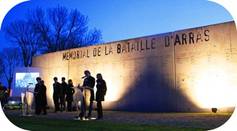 With so much emphasis on the 1 July commemorations on the Somme and the mass pilgrimage that takes place every year, this buy ambien sleeping tablets year please spare a thought for the men who fought in the 1917 Battle of Arras. It was the most savage infantry offensive of the war with the highest daily rate of casualties – over 4,000 men per day. The campaign started with enormous success on Easter Monday, 9 April 1917 with the greatest advance of the war to date but ended in disillusionment and utter exhaustion 39 days later in the fields around Oppy, Roeux, Monchy-le-Preux and Cherisy. Arras is by far my favourite place to visit – there is something about it that I just can’t get enough of and even when driving down to the Somme for a tour, recce or meeting I feel a slight wistfulness as I pass the Vimy Memorial, the grain silos at Roeux, so close to the site of the dreaded Chemical Works and the spire of Monchy church with Monchy British Cemetery in the foreground.
With so much emphasis on the 1 July commemorations on the Somme and the mass pilgrimage that takes place every year, this buy ambien sleeping tablets year please spare a thought for the men who fought in the 1917 Battle of Arras. It was the most savage infantry offensive of the war with the highest daily rate of casualties – over 4,000 men per day. The campaign started with enormous success on Easter Monday, 9 April 1917 with the greatest advance of the war to date but ended in disillusionment and utter exhaustion 39 days later in the fields around Oppy, Roeux, Monchy-le-Preux and Cherisy. Arras is by far my favourite place to visit – there is something about it that I just can’t get enough of and even when driving down to the Somme for a tour, recce or meeting I feel a slight wistfulness as I pass the Vimy Memorial, the grain silos at Roeux, so close to the site of the dreaded Chemical Works and the spire of Monchy church with Monchy British Cemetery in the foreground.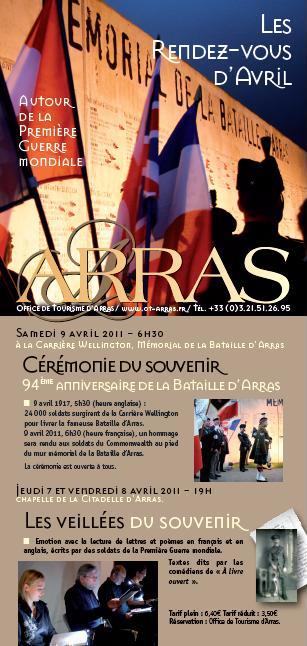
I have just received details of the annual commemorative service to be held at the Wellington Quarry, Arras on Saturday 9 April 2011 at 0630hrs (local time). This service, held on the 94th anniversary of the start of battle is held at the Memorial Wall – if you come into the car park from the Beaurains road then you won’t miss it. The ceremony is open to all.
Sadly, owing to work and family commitments I will not be able to make it this year but have passed my apologies on to Isabelle Pilarowski and her colleagues. I know that the organisers like to use extracts from soldiers who actually took place in the battle and, having given Isabelle a copy of the 1000 page memoir of Percy Clare, 7th East Surrey Regiment, she has promised that she will be using his superb descriptions of battle during the service. Percy’s memoirs were used extensively in the Arras panorama book – from his descriptions of pre-battle training, through the 9 April attack and subsequent days spent between Arras and the fields below Monchy ending with the fateful 3 May attacks – a very black day for the Third Army.
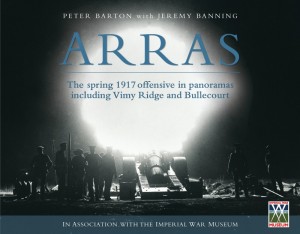 As a way of thanking the copyright holders we gave them a highly personalised tour of the Arras battlefield (following the 7th East Surreys) when they came over in November 2010 to listen to our lecture in French. More details can be found by reading the blog post here: Arras – battlefield tour & lecture: 12 November 2010
As a way of thanking the copyright holders we gave them a highly personalised tour of the Arras battlefield (following the 7th East Surreys) when they came over in November 2010 to listen to our lecture in French. More details can be found by reading the blog post here: Arras – battlefield tour & lecture: 12 November 2010
A two-sided pdf file with more details on April’s events is available on request – please contact me here and I will email you a copy.
These events include guided walks & tours (French speaking only) in Neuville-St-Vaast, Roeux and Arras itself and seem very good value at just €3.00 per person.
I will certainly have the men of the Third Army in my memories on the morning of 9 April and would urge anyone over on a battlefield tour at that time to attend and pay their respects.
The past week has been very busy with preparations for the talk in Arras at the Wellington Quarry that Peter Barton and I are doing on 12 November in French to local media & invited guests. Peter is doing 40 minutes and I am doing 5 minutes but he can speak French and mine is very GSCE-level so I thought it a fair trade off!
We are meeting Rachel Gray, great-niece of Percy Clare, 7th East Surrey Regiment whose hitherto unused memoir was used extensively in the Arras panorama volume. It will be a tremendous opportunity to show Rachel the battlefield where Percy fought in April & May 1917 and I should imagine it will be an emotional day all round. In my experience his memoir is unsurpassed in detail and we will literally be able to ‘walk in his footsteps’. The Bucks Herald are running this story for us as Rachel lives in their readership area. Many thanks to Nicholas Moore for his help with this. Link to be included when it goes online.
I have also been in touch with the Bristol Evening Post who are coming around on Thursday. Whilst on the archaeological dig on the Somme in May looking for parts of the Livens Large Gallery Flame Projector with Peter Barton buy xanax chicago & Tony Pollard (Centre for Battlefield Archaeology) we explored some caves under one of the churches in a nearby village. These caves were used as a refuge from German shelling by British soldiers – a safe and dry place to sleep. The walls are literally festooned with graffiti – names of the men who were billeted in these caves. One of the names particularly caught my eye – that of a man from just outside Bristol who had written his name, unit and home village as well as the date – 30 November 1916. I did a bit of research and found that, sadly, he was killed in March 1918. I will post more details on this plus the picture when the story is published.
The period around Armistice Day is always a busy time with the Great War in so many people’s minds through the Poppy Appeal. Coupled with upcoming research at Kew and the preview of the new ‘Valour’ Victoria Cross exhibition at the Royal Engineers Museum on 11 November as well as a battlefield trip this year is no exception. The strangest thing will be not being in Ypres (Ieper) on 11 November – I think I have only missed one year in the last ten.
I received an email from a mate of mine a few weeks ago telling me that he was planning a visit to the battlefields in late-May. He was coming with a few friends for a boy’s weekend with a bit of remembrance and battlefield touring thrown in for good measure. It so happened that they would be in Arras on the day when I was planning to return to the UK after three and a half weeks on the Somme archaeological dig with Cream Productions.
I couldn’t turn down a chance to give them a whistle-stop tour of the Arras battlefield and duly met them on the Saturday morning at Tilloy-lès-Mofflaines where I hopped in their car and gave them a running commentary around St.Laurent Blangy, Athies, Point du Jour, Fampoux, Roeux and the site of the infamous Chemical Works, Monchy-le-Preux and a walk up Infantry Hill, with a run back down the Arras-Cambrai road past Feuchy Chapel back to my car.
Whilst at Point du Jour we visited the graves of many of the Grimsby Chums (10th Lincolns) whose bodies were found in 2001 when foundations were being dug for a nearby BMW car factory. These bodies were buried with full military honours in the nearby cemetery in 2002. Sadly, positive identification of any of the remains proved impossible and all are now buried in graves marked with ‘unknown’ headstones.
One unexpected outcome of the whistle-stop tour was an answer I received to my usual question of ‘Did you have any relatives that fought in the war?’ One of the party, Rob, responded by telling me he was related to the Great War fighter ace, Albert Ball VC, DSO & Two Bars, MC. He had read about Ball’s exploits recently and this had stirred his interest in the visit. I was glad to hear that next day they all visited Ball’s grave in Annoeullin Communal Cemetery, German Extension.
So, whilst a lightning quick overview of a very small area, it was still a great way to spend a morning. It was also the first time that I had used the new Arras panorama volume on the battlefield – an mighty useful it was too! Many thanks to Rob, Chilts, Errol and of course, Pieman and his massive but silent car.

